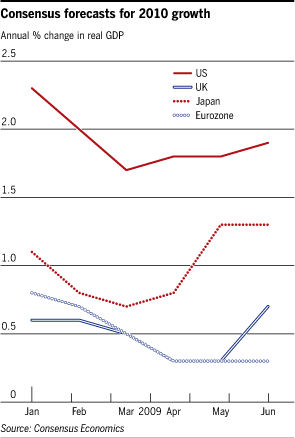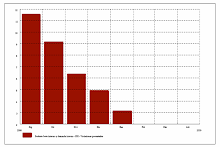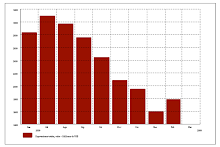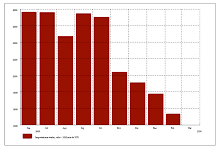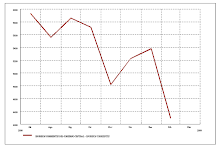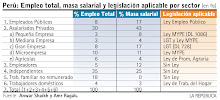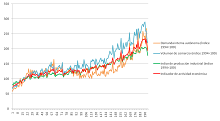'Green Shoots' of Recovery? Don't Fall for the Media's Economic Triumphalism
By Joshua Holland, AlterNet. Posted June 22, 2009.
A narrative is emerging that we're seeing the first signs that a recovery is around the corner, but the reality is less encouraging.
When a slew of absolutely depressing economic data were released in late May, economist Dean Baker, co-director of the Center for Economic and Policy Research,
wrote: "these reports might have led to gloomy news stories, but... the media have obviously abandoned economic reporting and instead have adopted the role of cheerleader, touting whatever good news it can find and inventing good news when none can be found."
In other words, the green shoots narrative should be met with healthy skepticism. New York University economist Nouriel Roubini -- who earned the moniker "Doctor Doom" for correctly anticipating the crash -- says that rather than "green shoots," we're seeing some "yellow weeds" emerging from the cracks of our shattered system, and argues that there's every likelihood that a "recovery" will mean several years of sluggish, below-average growth for the industrialized economies.
Most economists do agree that extraordinarily aggressive interventions by our government and those of other key countries -- whatever criticism one may have of their specifics -- have averted, for the moment, the worst-case scenario: a deflationary "death spiral" in which people don't spend, firms lay off workers and state revenues dry up just when they're needed the most, causing yet more austerity and more downsizing.
But as New York Times' columnist Paul Krugman noted, those moves "make the conventionally minded uncomfortable, and they keep pushing for a return to normalcy." And there are a variety of stakeholders that have a vested interest in creating a perception that we're "returning to normalcy." Wall Street is trying to repay the government (but without letting the taxpayers off the hook for future losses) in order to escape limits on executive pay and other watery "conditions" attached to the public's largesse (Goldman Sachs' research department has been out front in shaping the green shoots narrative). The Obama administration is fending off conservative charges that his stimulus package -- of which only a small fraction has actually been spent in the four short months since Congress approved it -- is a failure. The Fed and other institutions are anxious about foreign investors' perceptions of the U.S. economy's overall health, and economic reporters and pundits are loath to admit that they've been sleeping with the fetid corpse of a dead economic paradigm known as Reaganomics.
Moreover, much of the business establishment has an interest in heading off any attempt to fundamentally transform the economy. After all, when things go south in the 21st century, the big fish are protected -- they get a bailout.
So we need to ask not only if a recovery is really over the horizon, but also what it might look like.
Structural Imbalances Remain
Consumer spending in the U.S. accounts for not only about 70 percent of American economic activity, but also about a sixth of the planet's. Gallup notes that consumer confidence is edging up -- thanks in part, no doubt, to all the talk of green shoots -- but (self-reported) consumer spending has plummeted by a whopping 41 percent compared to the same time last year.
This is the culmination of a long-term problem. Most people's wages have not been stagnant in recent years-- it's worse than that. For more than three decades the real incomes of all but those in the top 10 percent of the economic pile have actually declined.
We kept up our lifestyles, though -- first through massive numbers of women joining the workforce, and later by running deep into debt. That central economic disconnect has only accelerated with the recession.
That was then; what happens now? Americans' household wealth -- assets minus debt -- has dropped for seven consecutive quarters; it's fallen to the tune of $13.8 trillion since the middle of 2007 (which represents the loss of about 20 percent). In just the first three months of this year, American families lost almost a half-trillion dollars in the value of their homes and almost thee times that number in stocks and other equities. So we're broke.
And our credit's maxed out -- American homeowners now own, on average, just 41 percent of the equity in their homes, an all-time low. The picture in terms of revolving debt (you know, the plastic) -- almost $1 trillion worth in the U.S. -- isn't much better; last month, U.S. credit card defaults also reached an all-time high.
Americans are "de-leveraging" -- paying down or defaulting on debt and putting some pennies away for a rainy day. In the first three months of this year, U.S. households shed over $100 billion worth; they paid down credit card debt at a rate unseen in 30 years. It's a good idea to live within one's means, of course, but the trend represents what's known as the "paradox of thrift": when things get tough people save their money, and dollars put in the bank aren't spent in the economy at a time when they're needed most.
According to Barron's:
De-leveraging -- paying down debt and boosting savings -- will continue to weigh on consumer spending even after employment and income eventually turn up, which is still far away. That's what makes this cycle different from the ones before.
In the past, the hits to wealth were concentrated in equities, which were held mainly by the well-to-do. And they were cushioned by their real estate, private business holdings, fixed-income securities and ample cash. In the bubble, however, even the rich got into hock with multiple homes that they now can't afford to carry and can't unload.
In other words, investors may be feeling a bit less bearish based on the fact that unemployment claims are down a fraction, but most Americans continue to feel the pain. And don't look for a new wave of consumers in developing countries to step up and fill the void -- that's incredibly unlikely over the short or medium terms.
And there are a number of other factors to consider when weighing the likelihood that a robust recovery is in sight.
Real Estate Hasn't Hit Bottom
Of late, one of the green shoots being touted is some modestly good news -- or less terrible news -- in the real estate market. Housing starts -- new construction -- were up slightly last month, indicating to some that we might be reaching a "bottom" in the real estate market's decline.
But a deeper look suggests that there's not much reason to rejoice. Starts were up 17 percent in May over April's figures, but April was dead; new construction in May was still down by almost half compared to the same period last year.
Dean Baker also notes that new mortgage applications are very low, and builders' confidence is in the tank -- those in the construction industry aren't expecting a robust recovery anytime soon. Baker suggests that builders moving up planned projects to take advantage of the first-time homeowners' tax credit, which expires in November, is a likely cause of the rise in starts.
During the growth of the housing bubble, there was an enormous boom in construction, and inventories of unsold homes are now at about twice their historic levels. Economist Robert Schiller predicts that real estate prices may continue to decline for years to come, as they did in Japan following the burst of its real estate bubble in the 1990s.
And there are ominous signs that the worst is yet to come. Most disturbing is the "shadow inventory" of foreclosed homes that are not on the market, either because investors are holding out for better times or, more commonly, because banks don't want to take losses on their balance sheets, as they must do when a sale is made at a loss.
The Christian Science Monitor notes that "only 30 percent of foreclosed homes are currently on the market, meaning that some 500,000 sit vacant across the country, part of a vast 'phantom inventory' that the market has yet to grapple with."
As if that weren't enough, "option ARM" loans -- with very low interest rates for the first few years which then "reset" higher -- were popular during the boom. People figured they'd score a place, hold onto it for a few years and then have no trouble selling it down the road for a handy profit. But now many of those homeowners are unable to sell, and a million of them will face steep increases in their monthly payments over the next four years -- with about 750,000 resetting in the next two years alone. Susan Wachter, a professor of real estate finance at the Wharton School of Business, told Bloomberg News that as rates reset, it "will drive up the foreclosure supply, undermining the recovery in the housing market. … The option ARMs will be part of the reason that the path to recovery will be long and slow."
Other Shoes to Drop
Gas Prices:
They're up by more than 60 percent since the end of 2008, and it's likely to get worse. Crude oil prices have doubled during the same period, and the cost of refined gasoline appears to be lagging behind that of crude oil because demand has been low -- down globally by 2.6 million barrels per day over last year -- and oil stocks are high. As the economy starts chugging along again, demand will increase, and prices are likely to continue to rise. Most analysts expect the price of crude oil to increase by as much as 40 percent (from around $70 per barrel now) over the next year. The New York Times reported that "the national jump in prices, far larger than the normal seasonal increase, is pulling billions of dollars from the pockets of drivers. It threatens to curtail a modest recovery in consumer spending on items like apparel and electronics."
Risk of Inflation:
So far, firms and households have stopped buying, and that has kept inflation in check even as the Fed and other countries' central banks are pumping money into the system. But, according to Nouriel Roubini, "if central banks don't find a clear exit strategy from very easy monetary policies that have led to the doubling or tripling of the monetary base in the U.S. alone, eventually inflation and/or another dangerous asset and credit bubble will ensue when the global economy gets out of this severe recession" (the "monetary base" is the amount of cash in circulation combined with commercial banks' reserves at a given point in time).
The amount of public debt has gone through the roof and will continue to do so in the foreseeable future. Deficit spending is necessary when consumers and businesses tighten their purse strings, but there are consequences -- spiraling public debt. Policymakers may be tempted to "inflate their way" out of the problem -- inflation decreases the real value of the dollars one owes to other parties.
Krugman dismisses fears of inflation as ideologically grounded fearmongering, noting that in past recessions policymakers have deemed the strategy too painful to pursue. But as Roubini notes, "Inflation may indeed become the path of least resistance for policymakers, as it is easier to run the printing presses and cause inflation than it is to implement politically difficult tax increases or spending cuts."
Rising Interest Rates:
So far, fears of a massive run away from the dollar as the world's reserve currency or of foreign investors fleeing the U.S. market appear to be overstated. "Talk that foreign central banks will diversify out of their dollar and Treasury holdings is so far just talk," Chris Rupkey, chief financial economist at Bank of Tokyo-Mitsubishi, told Bloomberg News. "The worst financial crisis since the Great Depression is still ongoing, and foreign investors and central banks still have a safe haven demand for U.S. Treasuries."
But the demand for U.S. assets has declined in recent months, and as the public debt increases, the amount we'll have to pay on that debt in order to keep selling it will likely increase. That will create upward pressure on interest rates which may further limit the recovery in the medium term as businesses and families face higher interest rates for financing various purchases.
Tax Cuts Expiring:
The Bush-era tax cuts were an abomination of priorities; at the end of Bush's term in office, the top 1 percent of Americans bore the lowest share of the tax burden and raked in the largest chunk of the national income at any point in at least the last 20 years. It's good that they are set to expire -- it'll raise revenues and restore a semblance of equity to a system that's become painfully skewed toward the interests of an exceedingly small and very wealthy minority.
But in purely economic terms, it's likely to be another impediment to a robust recovery -- those cuts will expire at just around the time many green shoots optimists expect a return to at least respectable growth at the end of this year.
Similarly, (good) "cap-and-trade" legislation, if it passes Congress, is necessary for curtailing greenhouse gas emissions and averting catastrophic climate change. But it will result in an effective tax hike that may also slow down any potential recovery. (Again, this is not an argument for extending the Bush tax cuts or opposing new regulation of greenhouse gasses.)
Yellow Weeds
There are other potential obstacles to a robust recovery that are more technical in nature. Readers interested in a wonkier analysis should check out Roubini's piece, "Ten Risks to Global Growth." In it, he notes that one "cannot rule out a sharp snapback of [economic activity] for a couple of quarters, as the inventory cycle and the [stimulus spending] lead to a short-term growth revival." But "unless structural weaknesses are resolved," he predicts that climbing indicators over the short term will prove to be only an illusion of economic health.
Yet the green shoots crowd predicts an end to the recession -- already the longest and most painful in decades -- toward the end of this year. They see it as a V-shaped dip -- a sharp decline followed by an equally strong period of recovery. That's what has happened in recent decades, following "normal" periods of recession.
But a more likely outcome is a U-shaped recession ending (that is, being declared over -- wages and employment typically lag behind the official end of a recession) sometime next year, with a long and painful tail, which may then be followed by a period of less-than-stellar economic performance for several years.
And it's entirely possible that those other shoes will fall, pushing us into a W-shaped double-dip recession -- with a bit of growth followed by a second period of contraction -- which would be unlike anything we've experienced in recent memory.
So, some key questions: For all the optimistic chatter about green shoots, what kind of so-called recovery will we actually experience? How can we have a "return to normalcy," whatever that is, if we refuse to initiate the kind of structural changes that would lead to widely shared prosperity -- the widespread economic security that a consumer-driven economy like ours requires in order to sustain growth? Will we start building things again? Will we balance our trade deficit?
Washington's maneuvers may have slowed our descent, but so far, these questions remain largely unaddressed.
![[Most Recent Quotes from www.kitco.com]](http://www.weblinks247.com/indexes/gfms.gif)
![[Most Recent Quotes from www.kitco.com]](http://www.kitconet.com/charts/metals/base/spot-copper-30d.gif)
![[Most Recent Quotes from www.kitco.com]](http://www.kitconet.com/charts/metals/base/zinc-d.gif)
![[Most Recent Quotes from www.kitco.com]](http://www.kitconet.com/charts/metals/base/lead-d.gif)
![[Most Recent Quotes from www.kitco.com]](http://www.kitconet.com/charts/metals/base/spot-nickel-30d.gif)


